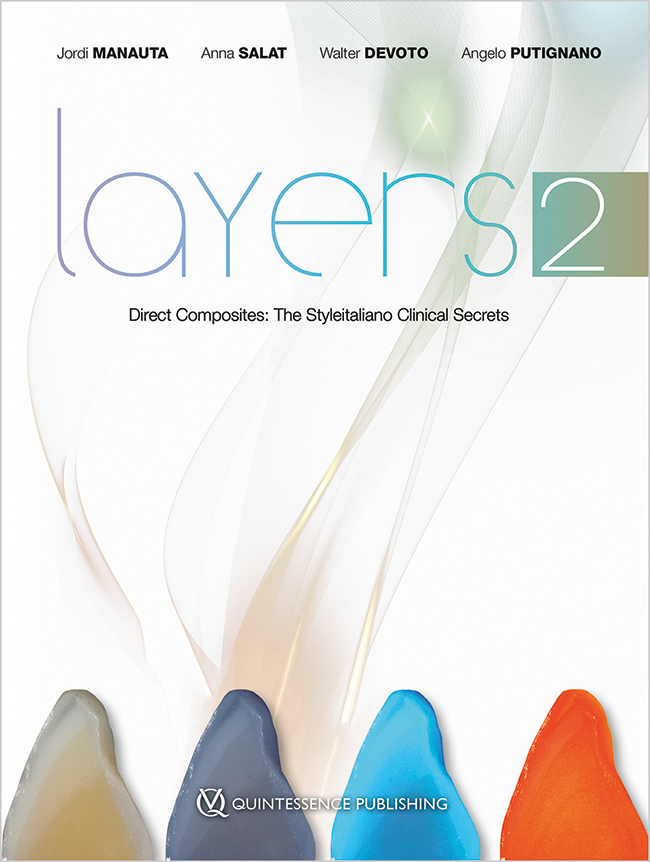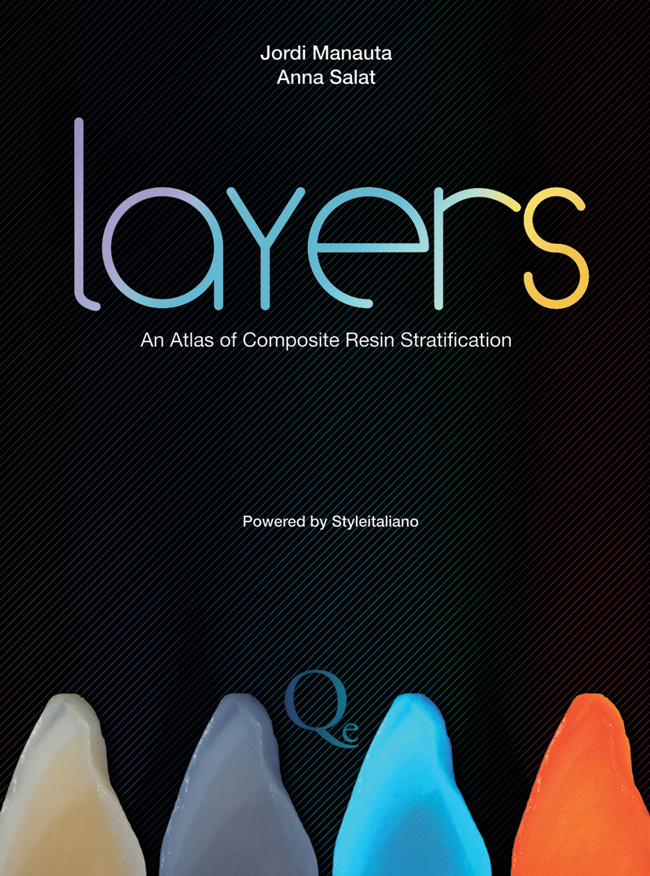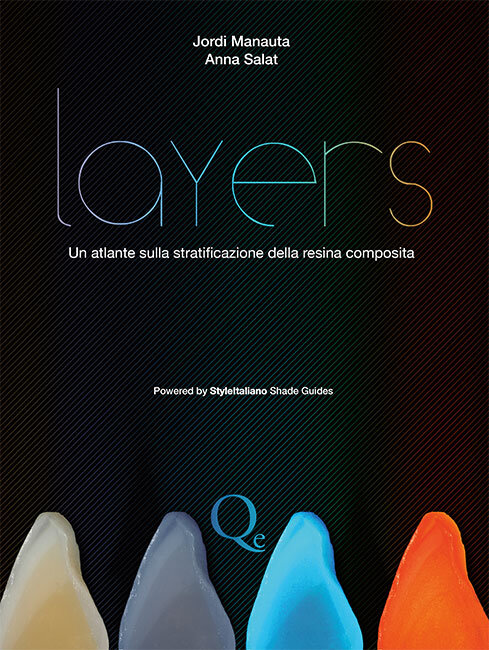International Journal of Esthetic Dentistry (DE), 4/2022
Clinical ResearchSeiten: 404-419, Sprache: DeutschManauta, Jordi / Salat, Anna / Monterubbianesi, Riccardo / Tosco, Vincenzo / Devoto, Walter / Orsini, Giovanna / Putignano, AngeloDas Schließen von Diastemata mit direkten Kompositrestaurationen ist weiterhin eine echte Herausforderung für den Zahnarzt. Die besondere Schwierigkeit dabei liegt in der Herstellung eines korrekten Approximalkontakts und zervikalen Emergenzprofils. Im vorliegenden Artikel wird eine neue Technik für den Diastemaschluss und die Zahnformveränderung im Frontzahnbereich mithilfe direkter Kompositrestaurationen beschrieben. Die sogenannte Front-Wing-Technik (FWT), die hier vorgestellt wird, verzichtet auf ein klassisches Wax-up und die Verwendung eines Silikonschlüssels. Bislang existiert keine zuverlässige Methode dafür, die im Wachs modellierte Anatomie auf die zervikale und approximale Form von Kompositrestaurationen zu übertragen, um diese Bereiche des Zahns zu korrigieren oder wiederherzustellen. Die FWT bietet einen neuen Ansatz für die freihändige Modellierung des Emergenzprofils ohne Hohlraumbildung. Der im vorliegenden Artikel gezeigte Beispielfall illustriert den Schluss von Schneidezahndiastemata im Ober- und Unterkiefer und diskutiert die Überlegungen hinter den einzelnen Arbeitsschritten. Die Technik sollte als alternativer Ansatz für direkte Kompositrestaurationen im Frontzahnbereich in Betracht gezogen werden, da sie die Behandlungszeit verkürzt und Kosten spart.
International Journal of Esthetic Dentistry (EN), 4/2022
Clinical ResearchPubMed-ID: 36426611Seiten: 378-393, Sprache: EnglischManauta, Jordi / Salat, Anna / Monterubbianesi, Riccardo / Tosco, Vincenzo / Devoto, Walter / Orsini, Giovanna / Putignano, AngeloClosing a diastema with a direct composite restoration still represents a real challenge for clinicians, mainly due to the need to create a correct contact point and emergence profile at the cervical level. The present article describes a novel anterior direct composite restoration technique for closing diastemata and changing tooth shape. The proposed technique, called the Front Wing Technique (FWT), does away with the use of the traditional wax-up and silicone index-based procedures. To date, there has been no effective way to transfer the anatomy modeled in the wax to the interproximal cervical area of anterior restorations every time these areas need to be corrected or restored. Therefore, the FWT provides a new approach to freehand model the emergence profile without gap formation. The cases in this article demonstrate the closure of maxillary and mandibular incisal diastemata, with the rationale behind each clinical step of the FWT described. This technique should be considered an alternative approach for the direct composite restoration of anterior teeth, saving chair time and cost.
International Journal of Esthetic Dentistry (DE), 2/2021
Seiten: 182-198, Sprache: DeutschChiodera, Giuseppe / Orsini, Giovanna / Tosco, Vincenzo / Monterubbianesi, Riccardo / Manauta, Jordi / Devoto, Walter / Putignano, AngeloDer Bedarf an direkten Kompositrestaurationen im Seitenzahnbereich wächst. Die Ausführung dieser Restaurationen und insbesondere die Reproduktion der anatomischen Details dieser Zähne bereitet den meisten Zahnärzten jedoch Schwierigkeiten. Aufgrund der Fortschritte bei den Materialien und Füllungstechniken werden inzwischen zunehmend Kompositrestaurationen eingesetzt. Direkte Kompositrestaurationen werden üblicherweise mit der zeitaufwendigen Inkrementtechnik realisiert, um die Polymerisationsschrumpfung zu minimieren. Dabei wird die Füllung in separat gehärteten Schichten (Inkrementen) aufgebaut. Dank überlegener physikalischer und chemischer Eigenschaften der neueren Bulk-Fill-Komposite kann die Inkrementtechnik durch eine zeitsparendere Bulk-Fill-Technik ersetzt werden, wobei das Komposit in einem Zug bis auf das Niveau der Okklusalfläche appliziert und sofort modelliert wird. Der vorliegende Artikel stellt eine innovative Technik für direkte Kompositrestaurationen im Seitenzahnbereich vor. Diese Technik mit der Bezeichnung „Essential Lines“ ist einfach, ästhetisch und zeitsparend. Sie kombiniert die Vorteile der Bulk-Fill-Technik mit einer Modelliertechnik, die anhand kleiner schematischer Linien die Zahnanatomie wiederherstellt. Sie lässt sich gleichermaßen von Berufsanfängern wie erfahrenen Behandlern in unterschiedlichen klinischen Situationen einsetzen, um direkte Kompositrestaurationen mit optimaler Funktion und Ästhetik auf Seitenzähnen zu realisieren.
International Journal of Esthetic Dentistry (EN), 2/2021
PubMed-ID: 33969973Seiten: 168-184, Sprache: EnglischChiodera, Giuseppe / Orsini, Giovanna / Tosco, Vincenzo / Monterubbianesi, Riccardo / Manauta, Jordi / Devoto, Walter / Putignano, AngeloThere is a continuing increase in demand for the direct restoration of posterior teeth with resin-based composites. However, the execution of these restorations, especially the reproduction of the anatomical details of the tooth, still presents difficulties for most clinicians. Nowadays, resin-based composite restorations have become increasingly popular due to the development of new materials and filling techniques. Direct composite restorations are usually performed using the time-consuming incremental filling technique, which minimizes polymerization shrinkage. With this technique, the composite is built up in individually cured increments. Due to the superior physical and chemical properties of the newer bulk-fill composites, it is possible to replace this incremental filling technique with a more time-efficient bulk-fill technique, whereby the composite is placed and modeled in a single layer up to the occlusal surface. This article presents this novel technique for direct posterior composite restorations. The technique, called Essential Lines, is simple, esthetic, and time saving. It combines the advantages of the bulk-fill technique with a modeling technique that utilizes minimal so-called diagram lines to restore the tooth anatomy. This procedure can be used by beginners and expert practitioners alike in various clinical situations to produce direct posterior composite restorations with optimal function and esthetics.
International Journal of Esthetic Dentistry (DE), 2/2014
Seiten: 176-194, Sprache: DeutschPaolone, Gaetano / Orsini, Giovanna / Manauta, Jordi / Devoto, Walter / Putignano, AngeloEin zuverlässiges System für die Farbnahme bei direkten Kompositrestaurationen zu finden, ist für den klinischen Behandler oftmals eine Herausforderung. Die Autoren dieses Beitrags analysierten mehrere auf dem Markt befindliche Farbskalen für Kompositrestaurationen und fanden folgende Einschränkungen: unübliche Materialstärke der Proben; Proben nicht aus dem Material, aus dem der Kliniker den Zahnersatz herstellt; nur selten können Schmelz- und Dentinfarben übereinandergelegt werden. Anschließend untersuchten die Autoren die Zuverlässigkeit eines Systems, bei dem standardisierte Farbskalenproben mit anatomischer Zahnform selbst gefertigt werden. Bereits kleine Veränderungen der Materialstärke des Schmelz- Komposits können die ästhetischen Ergebnisse deutlich verändern. Die Ergebnisse zeigten, dass alle Proben, die mit diesem System hergestellt wurden, eine vergleichbare Materialstärke des Schmelzes in allen untersuchten Bereichen (zervikales, mittleres und inzisales Drittel) aufwiesen.
International Journal of Esthetic Dentistry (EN), 2/2014
PubMed-ID: 24765625Seiten: 164-182, Sprache: EnglischPaolone, Gaetano / Orsini, Giovanna / Manauta, Jordi / Devoto, Walter / Putignano, AngeloFinding reliable systems that can help the clinician match the color of direct composite restorations is often an issue. After reviewing several composite shade guides available on the market and outlining their main characteristics and limits (unrealistic specimen thickness, not made with the same material the clinician will use, only a few allow to overlap enamel tabs on dentin ones), the authors evaluated the reliability of a system designed to produce self-made standardized "tooth-shaped" shade guide specimens. Small changes in composite enamel thickness may determine huge differences in esthetic outcomes. In conclusion, the results showed that all the specimens demonstrated comparable enamel thickness in all the examined areas (cervical, middle, incisal).
International Journal of Esthetic Dentistry (EN), 3/2011
PubMed-ID: 21876865Seiten: 280-296, Sprache: EnglischSalat, Anna / Devoto, Walter / Manauta, JordiAchieving similar features to those on natural teeth is a common problem with esthetic restorations. Color matching is a fundamental procedure required to perform a predictable composite resin restoration. It is no longer enough to measure these criteria with conventional shade guides, which provide the hue and chroma, but do not take into account other dimensions of the tooth such as value, intensives, opalescence and characterizations.
The present article presents a simple and effective technique for color selection using a digital photograph of the tooth and an image-editing program such as Adobe Photoshop or Picture Project. The digital editing of the photograph with two simple steps described in this paper reveals the internal structures of the tooth easily.
The modified photographs highlight the opalescence, white spots, shape of the internal mammelons and other features that are not visible at first glance. This procedure provides an accurate color chart with which the clinician can begin an esthetic restoration process.
International Journal of Esthetic Dentistry (DE), 3/2011
Seiten: 302-318, Sprache: DeutschSalat, Anna / Devoto, Walter / Manauta, JordiDie Eigenschaften natürlicher Zähne zuverlässig zu reproduzieren, ist bei ästhetischen Restaurationen oft problematisch. Dabei ist die korrekte Reproduktion der Farbe ein entscheidender Schritt, um mit Kompositen vorhersagbare Ergebnisse zu erzielen. Es genügt nicht, diese Eigenschaften mit konventionellen Farbmustern zu bestimmen. Diese berücksichtigen zwar Farbe und Sättigung, lassen jedoch andere Faktoren, wie Helligkeit, Intensitäten, Opaleszenz und Charakterisierungen des Zahns unbeachtet.
Der vorliegende Artikel zeigt eine einfache und effektive Technik zur Farbwahl mithilfe digitaler Fotografien der Zähne und einem Bildbearbeitungsprogramm wie Adobe Photoshop oder Picture Project. Die digitale Bearbeitung des Bildes in zwei einfachen Schritten macht die internen Strukturen des Zahns sichtbar.
Die modifizierten Bilder verstärken Opaleszenzen, Kreideflecken, die Form der Mamelons und andere Strukturen, die auf den ersten Blick nicht sichtbar sind. Mit diesem Vorgehen wird eine präzise Farbtabelle erstellt, auf deren Basis der Behandler eine ästhetische Versorgung in Angriff nehmen kann.
International Journal of Esthetic Dentistry (EN), 1/2010
PubMed-ID: 20305875Seiten: 102-124, Sprache: EnglischDevoto, Walter / Saracinelli, Monaldo / Manauta, JordiIn daily practice, composites are the materials most commonly used for restorative dentistry. They are used for preventive seals, microinvasive restorations, build-ups and complex direct and indirect restorations in posterior sections.
Indeed, it is in the anterior sections that composites have traditionally been used to the greatest effect, enabling clinicians to carry out complex restorations using direct techniques with notable esthetic and clinical results.
Recent product developments combined with clinical research on stratification make it now possible to utilize new composites that have excellent opalescence and fluorescence characteristics and provide an excellent color range to choose from.1,2
It is however, a common complaint among clinicians that the layering techniques are rather complex and it is difficult to make the right color choice. Paradoxically, they say that the appearance on the market of sophisticated materials, designed to give ever better results in the medium and long term, only makes it more difficult to make the correct decision.
Indeed, many of these colleagues, after the first buzz of enthusiasm, give up on the layering technique and opt for materials which they say are more simple or "mimetic."
In the present article, the authors will discuss these topics and make suggestions on how to acheive high quality results every day, both from an esthetic and clinical point of view. However, predictability of the results is more important, as predictability provides advantages in terms of the quality of work and economy for clinicians and patients.
International Journal of Esthetic Dentistry (DE), 1/2010
Seiten: 102-125, Sprache: DeutschDevoto, Walter / Saracinelli, Monaldo / Manauta, JordiIn der restaurativen Zahnmedizin sind Komposite die meistgenutzten Materialien für die tägliche Praxis. Sie werden für die präventive Versiegelung, mikroinvasive Restaurationen, Aufbauten und komplexe direkte und indirekte Restaurationen im Seitenzahnbereich verwendet.
Die besten Ergebnisse lassen sich mit Kompositen im Frontzahnbereich erzielen. Mit ihnen sind komplexe direkte Restaurationen möglich, die zu bemerkenswerten ästhetischen und klinischen Behandlungserfolgen führen.
Dank der jüngsten Produktentwicklungen und der klinischen Forschung zur Schichtung ist es inzwischen möglich, neue Komposite zu verwenden, die eine ausgezeichnete Opaleszenz, Fluoreszenz und ein hervorragendes Farbspektrum zur Auswahl bieten1,2.
Die Zahnärzte beklagen sich allerdings häufig darüber, dass die Schichttechniken ziemlich kompliziert seien und es auch schwierig sei, die korrekte Farbauswahl zu treffen. Paradoxerweise heißt es, dass es aufgrund der anspruchsvolleren Werkstoffe, die mittel- und langfristig noch bessere Ergebnisse ermöglichen, nur noch schwerer geworden sei, die passenden Materialien auszuwählen. Viele Zahnärzte sind zunächst sehr begeistert, geben die Schichttechnik dann aber wieder auf und wählen Materialien, die ihrer Meinung nach einfacher oder "mimetischer" sind. In dem vorliegenden Artikel gehen die Autoren auf diese Thematik ein und machen Vorschläge dazu, wie sich sowohl in ästhetischer als auch in klinischer Hinsicht hochwertige Ergebnisse erzielen lassen. Wichtiger ist allerdings die Vorhersagbarkeit der Ergebnisse, da sich die Qualität der Arbeit für den Behandler und Patienten leichter einschätzen lässt und wirtschaftlich interessant ist.







